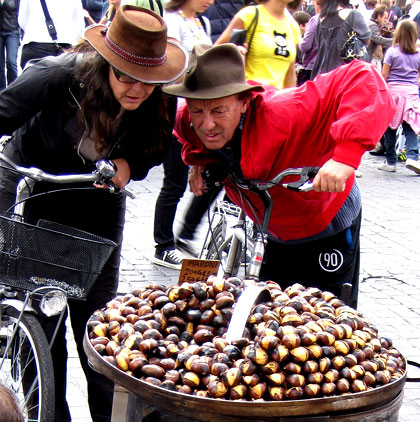
I must confess that I’m pretty sure I did not “get” chestnut beers until last Friday.
I understood they are a big deal in Italy. When we visited in in 2008, Birra Del Borgo founder Leonardo Di Vincenzo called them “the essence of Italian brewing.” More than 300 varieties of chestnuts grow in Italy, some of them earning a protected mark from the European Community. On any October weekend you’ll find a chestnut festival in at least one Tuscan village, each a celebration of local food products.
Scores of Italian breweries make chestnut beers, across a crazy range of “styles.” (Having taken original inspiration from a homebrewer, Di Vincenzo says.) Some were excellent, like Di Vincenzo’s own 4.2% abv CastagnAle, subtle and nuanced, or Palanfrina, a 8.5% abv monster from Birrificio Troll in the north. But even though they were nicely nutty, and sometimes — like CastagnAle — a touch smoky, I didn’t take a drink and think “chestnut.”
(Closer to home, Winged Nut, one of Urban Chestnut Brewing’s flagship beers, is made with chestnuts. Maybe those nuts — the the state of Missouri actively promotes them as an agricultural product — will mean more when the chestnut trees at the brewery grow larger, but for now I think of the beer as a nice dunkelweizen.)
I tried Chestnut Brown Ale from Country Boy Brewing primarily because brewing brothers Evan and Nathan Coppage tell a great story about what a pain in the butt it is to make. (Was to make; they the swear they never will again.) It was excellent, rich in the same way as good barbecue sauce. What I did not say upon tasting it was, “Nice expression of chestnut.” I was about halfway through the beer when it came time to open the bottle from Ale Apothecary I wrote about Wednesday. I put my beer down while I attempted to get a good photo.
When I picked the glass up and took a quick whiff there the memory was. Florence, late afternoon into evening, cobblestone streets, a vendor with roasted chestnuts, a gelato shop around the corner.
All in that glass. Pretty amazing.